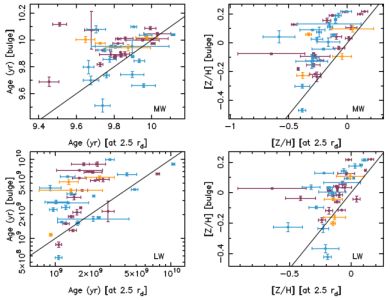


The age distribution of disks is of obvious importance for constraining scenarios of disk-bulge formation. Correlations between the disk and bulge colors have been found by several authors (Peletier & Balcells 1996, de Jong 1996, Bell & de Jong 2000, Carollo et al. 2001, Gadotti & dos Anjos 2001) which stands for both early and late type spirals. The similarity in color between inner disk and bulge has been interpreted as implying similar ages and metallicities for these two components and an implicit evolutionary connection (de Jong 1996, Peletier & Balcells 1996). However, using only colors one cannot directly transform the correlation in colors into correlations of age and/or metallicity.
A correlation between the line-strength index [MgFe]′ at one disk scale length and in the center was also found by Moorthy & Holtzman (2006). They interpret this as a correlation between the metallicity of bulge and disk as this index is more sensitive to variations of metallicity than age and it is almost insensitive to variations of [α / Fe].
More recently Sánchez-Blázquez & et al. (2014) performed a full spectral fitting analysis of a sample of 62 nearly face-on spiral galaxies observed as a part of the IFS survey CALIFA (Sánchez & et al. 2012) and showed that the slope of the relation between the luminosity-weighted age and metallicity and central velocity dispersion is similar for the central parts of the bulges and for the disk at ∼ 2.4 scale-lengths, but the bulges show higher luminosity-weighted ages and metallicities. Figure 11 shows the comparison of the mean values of age and metallicity (both weighted with mass and light) in the center and at 2.5 scale-lengths of the disk. A Spearman rank order tests reflect that, while the metallicities of both components are correlated, the same does not happen with the ages.
 |
Figure 11. Comparison of the average ages (left panels) and metallicity (right panels) weighted by both mass (top panels) and light (bottom panels) measured in the center and at 2.5 scale-lengths of the disk. Different colors indicate if the galaxy is barred (red), non-barred (blue) or weakly barred (orange). The solid line represents the 1:1 relation. For more details see Sánchez-Blázquez & et al. (2014). |
Note that the correlation exists for all early and late-type spirals, spherical and pseudobulges, contrary to the connection between the radial sizes of bulges and disks, that only exists for pseudobulges (Fisher & Drory 2008). Therefore either all bulges formed secularly and some had their bar destroyed or other physical processes are responsible for this correlation. Several authors have shown that the correlation between the disk and bulge sizes can exist in major and minor merger remnants. While minor mergers tend to preserve the original bulge-disk coupling of the main progenitor, major mergers are capable of rebuilding a bulge-disk coupling from the remnants after having destroyed the original structures of the progenitors (Querejeta et al. 2015 and references therein).
On the other hand, Morelli et al. (2012) rule out significant interplay between the bulge and disk components due to the similarity in the stellar population properties of bulges hosted in galaxies with very different disks (high- and low-surface brightness).